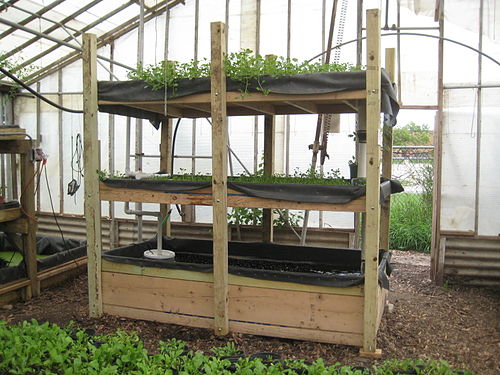Facts for Kids
Aquaponics is a sustainable farming method that integrates fish farming and plant cultivation in a symbiotic environment, where fish waste nurtures the plants and plants filter the water for the fish.
Overview
Future Of Aquaponics
How Aquaponics Works
History Of Aquaponics
Benefits Of Aquaponics
Types Of Aquaponics Systems
Aquaponics In Urban Agriculture
Aquaponics Vs Traditional Farming
Environmental Impact Of Aquaponics

Inside this Article
Sustainability
United States
New York City
Biodiversity
Aquaculture
Urban Areas
Fertilizer
Bacteria
Gravel
Did you know?
🌱 Aquaponics combines aquaculture (raising fish) and hydroponics (growing plants without soil).
🐟 Fish waste provides an organic nutrient source for the plants to thrive.
💧 Aquaponics systems use up to 90% less water than traditional farming methods.
🌍 This method of farming can be implemented in urban environments, promoting local food production.
🌞 Aquaponics can result in faster plant growth due to the nutrient-rich water from fish tanks.
🌿 You can grow a variety of crops in aquaponics, including leafy greens, herbs, and some fruits.
🐠 Common fish used in aquaponics include tilapia, goldfish, and catfish.
🔄 Aquaponics creates a closed-loop system, minimizing waste and maximizing efficiency.
🌡️ Temperature control is crucial in aquaponics to maintain fish health and plant growth.
🔬 Regular monitoring of water quality and pH levels is essential for successful aquaponics.
Introduction
In return, the plants clean the water for the fish. It’s a win-win situation! People can use this method in their backyards or even in big greenhouses. Aquaponics is not just fun, but also a sustainable way to grow food, helping us take care of the Earth while providing fresh veggies and fish to eat! 🍅💧
Future Of Aquaponics
More people are discovering how fun and beneficial it is to grow food this way! Schools around the world are even introducing aquaponics in their science classes to teach kids about sustainability and biology. 🏫👩🌾🌱 Researchers are also working on improving aquaponics technology to make it easier and more efficient. With increasing population and environmental changes, aquaponics could be a key solution for feeding the world while caring for our planet. 🌏
So get ready, the future of food is growing underwater! 🐠🍴
How Aquaponics Works
The plants grow in special media or floating rafts, taking the nutrients from the water. Finally, clean water goes back to the fish tank, creating a healthy cycle. This method is fun, educational, and helps communities grow their own food! 🌈🌍
History Of Aquaponics
Benefits Of Aquaponics
First, it uses less water than traditional farming, which is great for our planet! 💧
Second, it allows us to grow fish and plants together in the same system, creating fresh, healthy food without using harmful chemicals. It also grows food faster because plants can get nutrients directly from the water! 🥬🍴 Plus, people can set up aquaponics systems in small spaces, like backyards or rooftops, making it perfect for urban areas. 🌇
It’s a cool way to help families and communities stay healthy and green!
Types Of Aquaponics Systems
The most common type is the media-based system. In this system, plants grow in clay pebbles or gravel that holds moisture and helps roots breathe. 🪨
Another system is the nutrient film technique (NFT), where a thin film of water flows over plant roots. 🌊
Lastly, there's the floating raft system, where plants float on rafts in a big tank of water. These different systems are all fun to explore and can be set up in different ways to fit your needs! 👫👩🌾
Aquaponics In Urban Agriculture
️ In cities, space for growing food can be limited. 🏠
Aquaponics allows people to grow plants and fish in small areas, like rooftops and backyards! 🌿
For instance, cities like New York City and Chicago have established aquaponics farms that provide fresh produce and fish to local communities. 🍅🍣 This means healthier food options for everyone! 🌈
Plus, aquaponics can inspire kids and adults to learn about sustainability, food systems, and how to grow their own food in cities! 🌟🌻
Aquaponics Vs. Traditional Farming
In traditional farming, plants grow in soil and need chemical fertilizers and pesticides to help them grow. 😷
This can harm the environment. In contrast, aquaponics doesn’t use harmful chemicals; instead, it relies on fish waste as natural fertilizer! 🐟🌿 Also, aquaponics uses less water compared to traditional farming. For example, did you know aquaponics can save up to 90% more water? 🚰
So, aquaponics is more eco-friendly and can be done in urban areas where land is limited! 🌆
Environmental Impact Of Aquaponics
It uses fewer resources than traditional farming, helping conserve water and reducing pollution. 💚
By growing food without chemicals, aquaponics is healthier for our planet and our bodies. Additionally, aquaponics systems can be set up in urban locations, decreasing the need for transporting food over long distances, which saves energy! 🛒🛤️ It also promotes biodiversity by allowing different types of fish and plants to grow together. Overall, aquaponics can help us protect our environment while also providing fresh food! 🌿🌟

